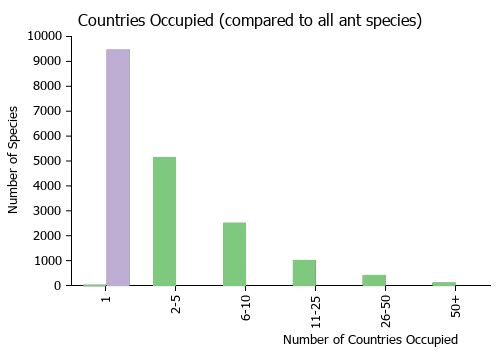Pseudoneoponera sublaevis
| Pseudoneoponera sublaevis | |
|---|---|

| |
| Scientific classification | |
| Kingdom: | Animalia |
| Phylum: | Arthropoda |
| Class: | Insecta |
| Order: | Hymenoptera |
| Family: | Formicidae |
| Subfamily: | Ponerinae |
| Tribe: | Ponerini |
| Genus: | Pseudoneoponera |
| Species: | P. sublaevis |
| Binomial name | |
| Pseudoneoponera sublaevis (Emery, 1887) | |
| Subspecies | |
| |
Colonies of this queenless species are among the smallest known in all ants : 9±2.5 workers (sample of 12 colonies) (Peeters et al. 1991). Occurs in Australian Eucalyptus forests.
| At a Glance | • Gamergate |
Identification
Distribution
Latitudinal Distribution Pattern
Latitudinal Range: -10.743702° to -33.931146°.
| North Temperate |
North Subtropical |
Tropical | South Subtropical |
South Temperate |
- Source: AntMaps
Distribution based on Regional Taxon Lists
Australasian Region: Australia (type locality).
Distribution based on AntMaps
Distribution based on AntWeb specimens
Check data from AntWeb
Countries Occupied
| Number of countries occupied by this species based on AntWiki Regional Taxon Lists. In general, fewer countries occupied indicates a narrower range, while more countries indicates a more widespread species. |

|
Estimated Abundance
| Relative abundance based on number of AntMaps records per species (this species within the purple bar). Fewer records (to the left) indicates a less abundant/encountered species while more records (to the right) indicates more abundant/encountered species. |

|
Biology
P. sublaevis reproduces via gamergates, but only a single worker in the colony is mated and performs all reproduction in the colony (Ito & Higashi, 1991; Peeters et al., 1991). Workers in a colony are organized in a strict linear hierarchy determined by age and by ritualized dominance displays (Higashi et al., 1994).
Colonies are exceptionally small (9±2.5 workers, sample of 12 colonies) (Peeters et al., 1991).
Castes
Winged queens are absent in this species
Images from AntWeb
   
| |
| Syntype of Bothroponera sublaevis. Worker. Specimen code casent0903892. Photographer Will Ericson, uploaded by California Academy of Sciences. | Owned by MSNG, Genoa, Italy. |
Nomenclature
The following information is derived from Barry Bolton's Online Catalogue of the Ants of the World.
- sublaevis. Bothroponera sublaevis Emery, 1887b: 442, 443 (in key, footnote) (w.) AUSTRALIA (Queensland).
- Type-material: syntype workers (number not stated).
- Type-locality: Australia: Queensland, Somerset (L.M. D’Albertis).
- Type-depository: MSNG.
- [Misspelled as sublevis by Dalla Torre, 1893: 36, and others.]
- Wheeler, W.M. 1918c: 299 (l.); Wheeler, G.C. & Wheeler, J. 1952c: 621 (l.); Wheeler, G.C. & Wheeler, J. 1971c: 387 (l.).
- Combination in Pachycondyla (Bothroponera): Emery, 1901a: 45;
- combination in Bothroponera: Taylor & Brown, 1985: 22;
- combination in Pachycondyla: Brown, in Bolton, 1995b: 310;
- combination in Pseudoneoponera: Schmidt, C.A. & Shattuck, 2014: 135.
- Status as species: Emery, 1911d: 77; Taylor & Brown, 1985: 22; Taylor, 1987a: 9; Bolton, 1995b: 310.
- Distribution: Australia.
- Current subspecies: nominal plus kurandensis, murina, reticulata (unresolved junior homonym), rubicunda.
Type Material
- Bothroponera sublaevis Emery, 1887: Syntype, 1 worker, Somerset, Queensland, Australia, Museo Civico di Storia Naturale, Genoa.
Description
References
- Brown, W. L., Jr. 1995a. [Untitled. Taxonomic changes in Pachycondyla attributed to Brown.] Pp. 302-311 in: Bolton, B. A new general catalogue of the ants of the world. Cambridge, Mass.: Harvard University Press, 504 pp. (page 310, combination in Pachycondyla)
- Emery, C. 1887f. Catalogo delle formiche esistenti nelle collezioni del Museo Civico di Genova. Parte terza. Formiche della regione Indo-Malese e dell'Australia (continuazione e fine). [part]. Ann. Mus. Civ. Stor. Nat. 25[=(2)(5): 433-448 (page 442, worker described)
- Emery, C. 1901b. Notes sur les sous-familles des Dorylines et Ponérines (Famille des Formicides). Ann. Soc. Entomol. Belg. 45: 32-54 (page 45, Combination in Pachycondyla (Bothroponera))
- Heterick, B.E. 2021. A guide to the ants of Western Australia. Part I: Systematics. Records of the Western Australian Museum, Supplement 86, 1-245 (doi:10.18195/issn.0313-122x.86.2021.001-245).
- Heterick, B.E. 2022. A guide to the ants of Western Australia. Part II: Distribution and biology. Records of the Western Australian Museum, supplement 86: 247-510 (doi:10.18195/issn.0313-122x.86.2022.247-510).
- Ito F & Higashi S. 1991. A linear dominance hierarchy regulating reproduction and polyethism of the queenless ant Pachycondyla sublaevis. Naturwissenschaften 78: 80–82.
- Peeters, C., S. Higashi & F. Ito 1991. Reproduction in ponerine ants without queens: monogyny and exceptionally small colonies in the Australian Pachycondyla sublaevis. Ethology, Ecology & Evolution, 3: 145-152.
- Rodrigues, M.S., Vilela, E.F., Azevedo, D.O., Hora, R.R. 2011. Multiple queens in founding colonies of the neotropical ant Pachycondyla striata Smith (Formicidae: Ponerinae). Neotropical Entomology 40, 293–299 (doi:10.1590/s1519-566x2011000300001).
- Schmidt, C.A. & Shattuck, S.O. 2014. The higher classification of the ant subfamily Ponerinae (Hymenoptera: Formicidae), with a review of ponerine ecology and behavior. Zootaxa 3817, 1–242 (doi:10.11646/zootaxa.3817.1.1).
- Taylor, R. W.; Brown, D. R. 1985. Formicoidea. Zool. Cat. Aust. 2:1- 149: 1-149, 30 (page 22, Combination in Bothroponera)
- Wheeler, G. C.; Wheeler, J. 1952c. The ant larvae of the subfamily Ponerinae - Part II. Am. Midl. Nat. 48: 604-672 (page 621, larva described)
- Wheeler, G. C.; Wheeler, J. 1971c. The larvae of the ant genus Bothroponera (Hymenoptera: Formicidae). Proc. Entomol. Soc. Wash. 73: 386-394 (page 387, larva described)
- Wheeler, W. M. 1918c. A study of some ant larvae, with a consideration of the origin and meaning of the social habit among insects. Proc. Am. Philos. Soc. 57: 293-343 (page 299, larva described)

